
POWER LEADER TM
PMCS 6.9
Installation Guide
GE Power Management Control System 6.9

POWER LEADER TM
PMCS 6.9
Installation Guide
GE Power Management Control System 6.9
Notice
The information contained in this document is subject to change without notice. GE makes no warranty of any kind with regard to this material, including, but not limited to, the implied warranties of merchantability and fitness for a particular purpose. GE shall not be liable for errors contained herein or incidental consequential damages in connection with the furnishing, performance, or use of this material.
This document contains proprietary information, which is protected by copyright. All rights are reserved. No part of this document may be photocopied or otherwise reproduced without consent of GE.
Copyright ??2001 by GE. Published in a limited copyright sense, and all rights, including trade secrets, are reserved.
The following are products of General Electric Company:
Microsoft, Microsoft Excel and Microsoft PowerPoint are registered trademarks, and Windows NT is a trademark of Microsoft Corporation.
DFP 100 and DFP 200 Feeder Management Relay?? and Multilin 269+ Motor Management Relay?? are registered trademarks of Multilin Inc., and Multilin SR489 Generator Management Relay??? and Multilin SR745 Transformer Management Relay??? are trademarks of Multilin Inc.
US Pat Nos 5,768,148; 5,764,155; 5,862,391

Introduction
Welcome
Hello and welcome to the POWER LEADER Power Management Control System for CIMPLICITY?? HMI. You are about to begin using your computer in an exciting new
This book is for anyone getting started with CIMPLICITY PMCS. It contains the information you need to install and begin using PMCS effectively.
???Chapter 2, Getting Started, explains the terminology of power- management systems, describes each of your PMCS items, outlines the minimum system requirements, and lists methods of getting GE Technical Support.
???Chapter 3, Installing the Software, explains how to prepare your system and install all of the PMCS software. Any special installation steps are outlined for each software module.
???Chapter 4, Configuring the Software, describes how to efficiently configure PMCS to get up and running in the shortest time.
???Chapter 5, EPM Device Special Considerations, details the additional configuration required to use EPM 7700, EPM 7600 and EPM 7500 meters in a PMCS network.
How to Use this Book
You will find this book easy to use if you look for these simple conventions:
???Boldface type indicates the name of an item you need to select.
???Monospace type indicates an example or text that is displayed on the screen.
???UPPERCASE type indicates a file name, command name, or acronym.

About CIMPLICITY PMCS Version 6.9
CIMPLICITY PMCS Version 6.9 is the latest Power Management Control System in the robust line of POWER LEADER
Performance
With
Features
PMCS comes with the following features that make the system more powerful and easy to use:
???Compatible with
???
???
???
???3D
???Improved waveform capture, including extensive analysis tools.
???Comprehensive alarm and event reporting for immediate diagnosis of electrical system problems.
???Multiple Viewer Workstation support for seamless access and sharing of
???Configurable password protection and
PMCS option modules are available to further increase productivity and reduce energy costs. Your system may include one or more of the following modules:
???CIMPLICITY PMCS Interface Toolkit with tools to quickly create accurate, intelligent floorplans,
???System Test Simulator to design and test PMCS systems without connection to real networks or devices.
Supported Devices
CIMPLICITY PMCS 6.9 supports the following devices. Firmware revisions other than those listed may not be compatible with PMCS. Contact your GE Sales Representative or the GE Resolution Center, at

Getting Started
First Steps
If you are already familiar with PMCS, simply review the system requirements and skip ahead to Chapter 3.
Getting started with PMCS is easy. This chapter explains power management and leads you through the steps to take prior to installing your PMCS software. If you need help with your PMCS system, the GE Technical Support telephone number is given at the end of this chapter.
Understanding Terminology
Baud rate: A measurement of a communication channel's signaling rate or
CIMPLICITY HMI: An
CIMPLICITY HMI Server Development: CIMPLICITY HMI Server Development allows you to create new projects and can also function as a runtime system.
CIMPLICITY HMI Server Runtime: CIMPLICITY HMI Server Runtime systems do not support project configuration. They may be used as runtime systems only.
CIMPLICITY HMI Viewer Runtime: CIMPLICITY HMI Viewer Runtime connects to Servers for viewing data and controlling actions.
Commnet: A GE Industrial Systems standard for device communications that specifies the communication protocol and the communication network.
Communication network: A physical standard for wiring and interconnection of communicating devices. A communication network standard usually includes specifications of voltages, maximum
cable requirements. RS485 and Ethernet are examples of
Communication protocol: A language or convention used for reliable transmission and reception of binary data. A communication protocol is often independent of the physical method or network used for transmission. Modbus RTU and TCP/IP are examples of communication protocol standards.
DDE Server: A software application that typically runs in the background, gathering information from the network and providing the information in DDE format for use by one or more applications. The PMCS DDE Server is included in the PMCS Network & Device Configurator and comes in versions optimized for Ethernet TCP/IP or RS485 Modbus RTU networks.
DDE: Dynamic Data Exchange. A Microsoft Windows standard for efficient sharing of data between applications on the same PC. See also NetDDE.
Ethernet Gateway: A POWER LEADER device used to connect four RS485 Modbus RTU networks to an Ethernet TCP/IP network. The Gateway increases performance of a PMCS system through multiple Modbus networks and reduces overall wiring costs through reuse of existing Ethernet LAN wiring.
Ethernet: An
Event Logger: A standard PMCS application that efficiently analyzes, sorts, and logs unusual system behavior such as circuit breaker trips, undervoltages, and overcurrents. Extensive
Host PC: The PC running the PMCS DDE Server is referred to as the Host PC. All other PCs running PMCS client programs are referred to as Viewer Workstations or networked PCs.
Interface Toolkit: An optional PMCS tool used to quickly generate accurate and friendly graphical user interfaces. The Interface Toolkit provides dozens of wizards to efficiently create intelligent
Modbus Concentrator: A POWER LEADER device used to connect eight commnet networks to an RS485 Modbus RTU network. The Concentrator provides full compatibility between the PMCS software and the extensive line of POWER LEADER devices with commnet communications, as well as simple expansion of a RS485 Modbus RTU network to up to 247 devices.
Modbus RTU: An
NetBEUI: A network protocol usually used in small,
NetDDE: A version of Dynamic Data Exchange (DDE) that allows communications between applications running on different PCs over network connections.
NT Service: A designated piece of software which runs in the background of Windows NT and can be set to automatically start when the machine is booted up. For example, the PMCS DDE Server can be set to operate as a Windows NT Service, rather than a
Server when operating as a Windows NT Service will not shut down when a user logs off.
ODBC: Open Database Connectivity. An
PMCS: Power Management Control System. GE???s
POWER LEADER: The family of GE
RS485: An
SCADA: Supervisory Control and Data Acquisition. A category of systems that primarily acquires data for logging and analysis, as well as providing supervisory control in applications without
TCP/IP: Transmission Control Protocol / Internet Protocol. An
Waveform Capture: A standard PMCS application that provides a window into
System Requirements
The following table shows the minimum and recommended PC system configuration for running PMCS Version 6.9. Note that regardless of configuration, the PC system must be Windows
Note: For systems using MMS technology, refer to Using MMS Servers with PMCS for minimum system requirements.
Additional hard disk space is recommended for increased storage of log and trend data. Also recommended are an uninterruptable power supply (UPS), 17??? or larger monitor, tape drive or other backup mechanism, and (if Remote Access technical support is desired) a 28.8 Kbps or faster modem.
The version of CIMPLICITY installed must be 4.01 or greater, and HMI Service Pack 9 must be installed. Also, the "Advanced DDE Communications" option must be installed.
Microsoft Internet Explorer 3.02 or later is required to run the EPM 7700 component help system. To take advantage of all available .HTML help features, Internet Explorer version 4.0 or higher must be installed. (The latest version of Internet Explorer is available at www.microsoft.com.)
Please note that the host PC requirements are directly tied to the complexity of your PMCS system. The minimum requirements will suffice for a simple PMCS system. However, as the number and complexity of your power management device grows, and you add more complex software requirements such as custom interfaces designed with
Where to Get Help
The GE Industrial Systems Resolution Center is available at
Also, technical notes are available on the Internet at: http://www.ge.com/industrialsystems/pmsys/Technote/noteidx.htm
What???s next?
The following chapters discuss the details of installing and getting quick results from your new PMCS software. Set aside at least an hour and be sure to follow the procedures carefully to guarantee correct installation of your PMCS software.
(This page left blank intentionally.)

Installing the Software
Computer Preparation
PMCS must be installed on a PC running Windows NT Workstation 4.0. This host PC must be dedicated to the PMCS system. Performance and data integrity cannot be predicted unless the PC is configured solely for the purpose of running PMCS.
The Windows NT System control panel offers a Performance tab that allows you to boost performance for the foreground application. For PMCS, must be changed to No Performance Boost for Foreground Application (default is Maximum), as shown below:
The Virtual Memory setting may be left at the Windows NT defaults.
Make sure your system meets these requirements before proceeding with the remaining installation steps. PMCS will not run correctly unless these requirements are satisfied.
Installing CIMPLICITY
If CIMPLICITY HMI was provided with your PMCS software, you must install it before proceeding. If your computer already has CIMPLICITY HMI installed, make sure the following requirements are met.
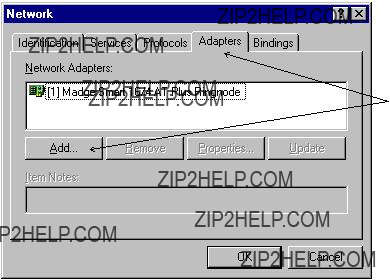
???CIMPLICITY HMI for Windows NT (Intel) Version 4.01 with HMI Service Pack 9 or CIMPLICITY HMI for Windows NT (Intel) Version 5.00 with HMI Service Pack 1is required. Other versions of CIMPLICITY may not be compatible with PMCS.
If you are installing CIMPLICITY HMI, follow the directions provided with the software (inside the CD jewel case). Choose CIMPLICITY HMI as the product to install, then select either the HMI Server or Viewer as the product option to install, and C:\CIMPLICITY\HMI as the installation directory. If you install the Server option, also install Server Option - Communications - Advanced DDE/DDE
Client.
Installing Additional Software
Install any additional software, such as Microsoft Excel, at this point in the procedure. Follow the instruction procedures provided by the manufacturer.
For instructions on installing SISCO Systems' MMS Server for use with PMCS, refer to the section titled Using MMS Servers with PMCS.
RS485 PMCS Network Interfaces
If you are using an RS485 interface card to connect to the PMCS network, install the card following the manufacturer???s installation instructions. Be sure to install any Windows NT drivers provided by the
From the Network control panel, select the Adapters tab, then click Add.

Select the appropriate network adapter from the list and click Have Disk???. Follow the instructions provided on the screen to complete the network card installation.
For PMCS systems using one or more GE Multilin RS232 to RS485 converters (or equivalent), no additional drivers are required.
Ethernet PMCS Network Interfaces
If you are using an Ethernet interface card to connect to the PMCS network through one or more Ethernet Gateways or directly to a network of Universal Relays (Modbus TCP/IP), follow the manufacturer???s installation instructions and be sure to install the provided Windows NT drivers using Control Panel>Network>Adapters>Add Adapter. Refer to the screen shots above for an example, though the selections will differ based on the hardware you are installing.
Ethernet requires the TCP/IP protocol for compatibility with the Ethernet Gateway or Universal Relays. TCP/IP should have been installed with Windows NT Workstation 4.0; you can check this using Control Panel>Network>Protocols. The screen shot below shows a system with TCP/IP installed. If TCP/IP is not installed on your system, refer to the Windows NT documentation for installation instructions.
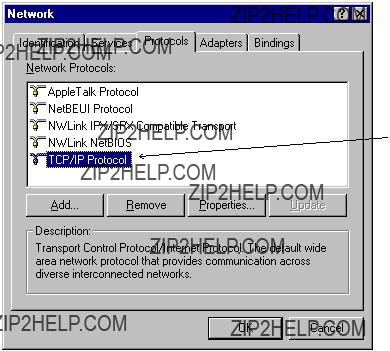
Ethernet users:
Check the
Protocols tab of the
Network control panel for TCP/IP Protocol.
Local Area Network (LAN) Interfaces
PMCS supports multiple Viewer Workstations through links over a local area network. Thus, in addition to the PMCS network interface, the Host PC may also have a LAN interface.
A Host PC with an Ethernet PMCS network interface may use either the same Ethernet card as the LAN interface or a separate LAN interface card. A Host PC with an RS485 PMCS network interface requires an additional LAN interface card to support Viewer Workstations.
Typical LAN interface cards include Ethernet and Token Ring. Any LAN interface card should be installed according to the manufacturer???s instructions.
Installing Additional Software
Install any additional software, such as Microsoft Excel or COMTRADE file browsers for analyzing waveform files, at this point in the procedure. Follow the instruction procedures provided by the manufacturer.
Installing the EPM Software Components
The EPM 7700, EPM 7600 and EPM 7500 Meters require additional software to operate with PMCS client software such as the Event Logger, Waveform Capture Module, or CIMPLICITY Wizards. This is because the EPM 7700, EPM 7600 and EPM 7500 are not compatible with the standard PMCS DDE Server. Instead, a separate DDE Server called the 7700 Gateway Server must be installed, along with a pair of ???helper??? applications, the Communications Server and the ION_Link Server. The Communications Server processes all communications between the Gateway Server and/or the ION_Link and the
The EPM 7700 software may be selected during the standard PMCS installation routine. If you are not using any EPM devices in your PMCS setup, you do not need to install the EPM options during PMCS installation.
The EPM software components do require some special configuration beyond that required for other PMCS components. Refer to the section titled EPM Device Special Considerations for details after running the installation routine described in this section.

Installing the PMCS software
Once you have set up Windows NT and any
The diagram below depicts the relationship of the Host PC and any optional Viewer Workstations in your system. Follow the specific instructions below for software installation on Host PCs and Viewer Workstations.
eLicensing PMCS software
General Electric Industrial Systems has added security technology that requires your PMCS software to be licensed in order to run. A separate license is required for each computer that will receive PMCS. Each eLicense Order ID that is sent with your order corresponds to one license.
You license your software as part of the automated PMCS installation process. When you launch the installation process the first screen that will appear will be your eLicense Option screen (see below). This screen allows you to either trial or fully license your PMCS software.

30 Day Trial
You have the option to Trial PMCS for 30 days through the
Licensing via the Web
Choose the Web License option if you have a working internet connection on your PMCS computer. This option will automatically connect you to General Electric Industrial Systems??? eLicense distribution system. Once connected, an automated process will retrieve your unique PMCS eLicense key.
Selecting the Web License option from the License Option brings you to the Web License Screen. This screen requires you to enter your eLicense Order ID. This information is contained on the Order Confirmation Sheet that accompanied your PMCS software or it can be obtained from your Purchase Confirmation
Similar to the trial, each eLicense is registered to the computer In which case, the eLicense Order ID can only be used for one computer The software must be unlicensed to be
License by Phone
If your PMCS computer does not have an internet connection you may license your PMCS software over the phone by selecting the By Phone option on the Licensing Option Page. This will bring you to a Phone License screen. This screen provides a
Similar to the trial, each eLicense is registered to the computer In which case, the eLicense Order ID can only be used for one PMCS computer . The software must be unlicensed to be
Host PC Installation
Every PMCS system requires one Host PC that is directly connected to the PMCS network and communicates with the
If you are installing multiple PMCS catalog numbers on the Host PC, you will need the CD and serial number from each package. Follow the Installation Steps section below. If the Host PC will be providing data to View Nodes, be sure to refer to GEH- 6510, Network and Device Configurator, to configure NetDDE for operation with the View Node PCs.
Viewer Workstation Installation
PMCS supports optional Viewer Workstations, which interact with the power- management network through NetDDE links to the Host PC. Viewer Workstations are not directly connected to the PMCS network but are connected via LAN to the Host PC. Viewer Workstations are not mandatory in a PMCS system because the data is available for display and analysis at the Host PC. When installing PMCS View Nodes, be sure to use only an appropriate catalog number for the installation. Do not install any other PMCS software on a PMCS Viewer Workstation.

NOTE: The EPM software differs from the standard PMCS usage of Viewer Workstations. Refer to the section titled EPM Device - Special Considerations for more details on EPM Workstations and View Nodes.
PMCS Installation Steps
Follow the procedure below to install each PMCS catalog number. Be sure the catalog numbers you are installing are appropriate for the destination PC (Host PC or View Node). Close any open applications before installation.
1.Insert the PMCS Installation CD into the
2.Click the Start button from the Windows NT Task Bar and select Run.
3.In the Run dialog box, enter X:\setup (where X is the appropriate CD- ROM drive designation).
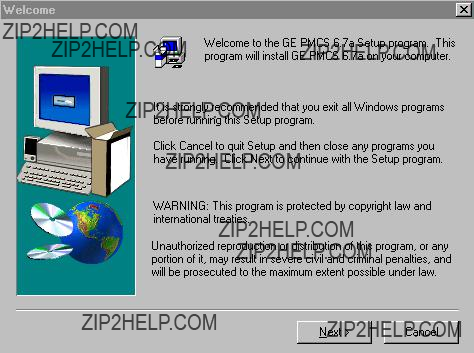
4.The GE PMCS 6.9 Setup screen appears as shown below. Read the general information and disclaimers shown on the screen, and click Next.
When you select the Next button in the Welcome screen, the PMCS license agreement screen is shown. Please take a moment to read over the license agreement, then click Next.

5.At the User Information screen shown below, enter your name, your company name, and the serial number for the PMCS component you are installing. Serial numbers for PMCS components are located on the PMCS
When you select the Next button in the User Information screen, a registration confirmation screen prompts you to verify your entries. Ensure that you have made no mistakes in the User Information fields, then continue.

6.At the Choose Destination Default is ???C???. Click Next
Location dialog, specify a drive on which to install PMCS. to continue.
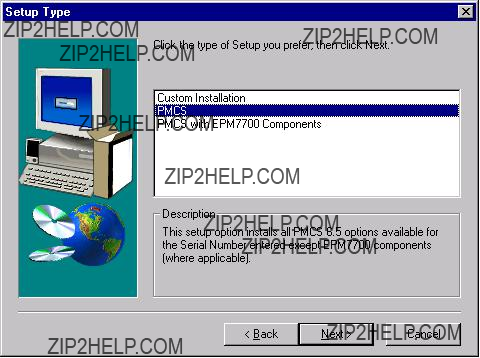
7.At the Setup Type screen, select either a Custom installation, standard PMCS installation, or PMCS with EPM 7700 Components. PMCS installation is recommended and will install all components for the PMCS catalog number you entered in the User Information screen. Select PMCS with EPM 7700 Components if you will be installing EPM 7700, EPM 7600 or EPM 7500 devices in your network. Select Custom if you wish to select specific PMCS software components to install. Click Next to continue.
If you select PMCS with EPM 7700 Components, you may also be required to view an additional license agreement for MS Data Access components. This software is required by the EPM 7700 software. Take a moment to read the license agreement information, then continue.

8.If you did not select ???PMCS with EPM 7700 Components??? in the Setup Type dialog box (Step 7), skip this step and proceed to Step 11.
If you are installing the EPM 7700 Components, select whether this is to be a Primary node installation or Secondary node installation. You must install at least one Primary node on your PMCS network; it is recommended that you install the Primary node at the same machine as the PMCS DDE Server for convenience in configuration. Secondary nodes are akin to PMCS view nodes and may be installed on remote machines to access EPM 7700 data from the Primary node. (For additional details on Primary and Secondary nodes, see the section on configuring EPM 7700 components later in this chapter.)

9.If you did not select ???PMCS with EPM 7700 Components??? in the Setup Type dialog box (Step 7) or if you selected ???Primary Node Installation??? in Step 8, skip this step and proceed to Step 11.
If you selected Secondary Node installation in Step 8, the following dialog box appears prompting you to select either "Full Station" or "Stationless" node installation. If you are installing software on a computer that will service EPM 7700, EPM 7600 or EPM 7500 IEDs directly, choose "Full Station". If you are installing software on a computer that will not be connected to IEDs but will be used to access data from other network workstations, choose "Stationless". For more details on EPM 7700 network configuration, refer to the EPM Device Special Considerations section later in this manual, or to
GE 7700 Gateway User???s Guide.

10.If you did not select ???PMCS with EPM 7700 Components??? in the Setup Type dialog box (Step 7), or if you selected ???Primary Node Installation??? in Step 8, skip this step and proceed to Step 11.
If you selected Secondary Node installation in Step 9, the following dialog box appears prompting you for the name of the computer on which the Primary Node is installed.

11.Select the Program Folder for PMCS installation. It is recommended that the default Program Folder be chosen. Click Next to continue.

12.If you chose the ???PMCS??? installation, you may be presented with one or more DDE Server selections depending upon the PMCS catalog number you entered in the User Information screen. Select only the DDE communications servers that you will be using in your system

13.Next, the installer prompts you to choose how you wish to install the PMCS components. You may install them as standard applications which may be launched from the Start menu, or you may choose to install the PMCS components as Window NT Services. NT Services can be set to start automatically when the machine is powered up, and have the powerful advantage of running in the background with no regard to users' logon/logoff cycles. For example, the PMCS Waveform Server, when set to run as an NT Service, continues to collect waveform data whether or not a user is logged on. (For further information on NT Services, refer to your Windows NT documentation.)
Choose whether to configure your PMCS components as NT Services, then select Next.

If you chose to configure NT Services, you'll also need to select the appropriate DDE Server. The Select DDE Sever Configuration dialog is displayed for this action. Select the DDE Server(s) you will be using with your application, then choose Next.

14.The Selected Components screen offers you the opportunity to verify the installation settings before any files are copied to your hard drive. Confirm that the installation settings are correct, then click Next. The installation program copies the appropriate files to your hard drive.
If you have selected the EPM 7700 System Components (either manually when performing a Custom install or automatically when PMCS with EPM 7700 Components install is selected), the installer will check your system for a copy of Microsoft Internet Explorer, version 3.02 or higher. This is because the EPM 7700 software components use .html- format help files which require Internet Explorer to view. If Internet Explorer is not found, the following dialog box appears:
If you wish to view the EPM 7700 software help files, you should separately install Microsoft Internet Explorer, version 3.02 or higher. (To take advantage of all available help system features, Internet Explorer version 4.0 or higher is required.) Internet Explorer is not included as part of PMCS. You may obtain the latest version of Internet Explorer by downloading it from www.microsoft.com.
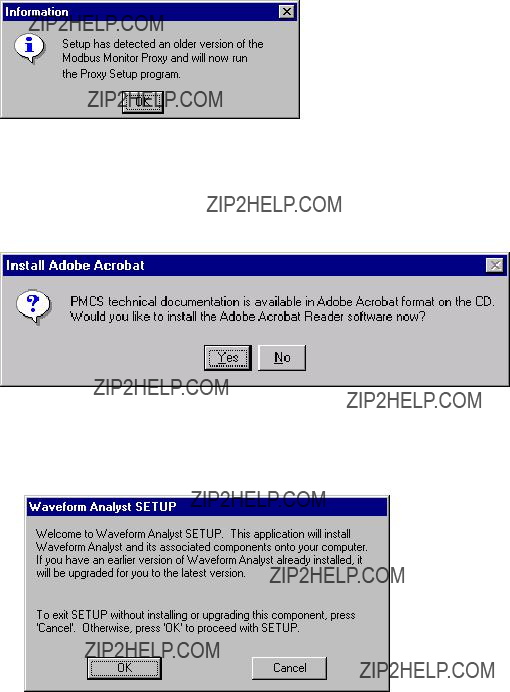
15.After completing the selected PMCS installation, the installation program checks the host PC for an older version of the POWER LEADER Modbus Monitor Proxy software. If the installer locates the Proxy software, it prompts you to update the Proxy to the PCMS 6.x- compatible version before finishing the PMCS installation routine. (If your system does not use POWER LEADER Modbus Monitor devices or does not have the Monitor Proxy software installed, the PMCS installer will skip this step.)
16.At this point, the installation program copies the appropriate files to your hard drive.
17.After the Setup program finishes installing the PMCS components you have selected, you will be prompted to install the Adobe Acrobat Reader software. If you do not have Acrobat Reader 3.0 or later installed on your PC, you may wish to install Acrobat Reader at this time. The PMCS
18.After the installation of Acrobat Reader, you will be prompted to install Waveform Analyst software. Install Waveform Analyst application to browse a large amount of power quality survey data with ease, using a graphical interface on a Microsoft Windows platform
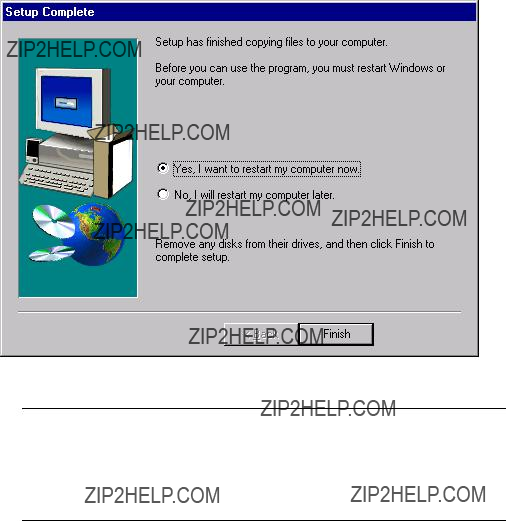
19.When all the installations are complete, the Setup Complete dialog box, shown below, prompts you to restart your computer.
After restarting your computer, be sure to view the ReadMe file to check any
NOTE: Your computer MUST be restarted after installing PMCS software. This step is critical to proper operation of the software, as it enables the following to happen:
???The operating system will register the new software components.
???The MMS Server (if installed) will update its alias table.
???Initial network configurations for EPM7700, EPM 7600 and EPM 7500 devices will be created.

PQ Analyst Installation Steps
Follow the procedure below to install each PMCS catalog number. Be sure the catalog numbers you are installing are appropriate for the destination PC (Host PC or View Node). Close any open applications before installation.
Insert the PMCS Installation CD into the
Click the Start button from the Windows NT Task Bar and select Run.
1.In the Run dialog box, enter X:\setup (where X is the appropriate
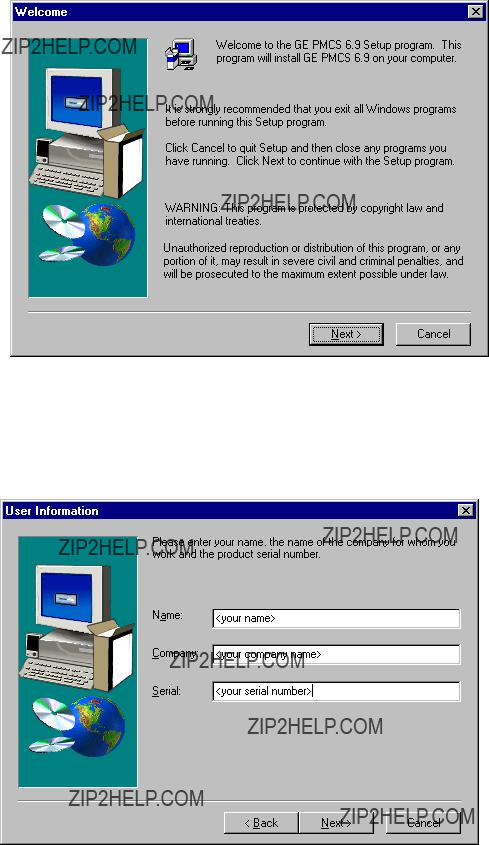
2.The GE PMCS 6.9 Setup screen appears as shown below. Read the general information and disclaimers shown on the screen, and click Next.
When you select the Next button in the Welcome screen, the PMCS 6.9 license agreement screen is shown. Please take a moment to read over the license agreement, then click Next.
3.At the User Information screen shown below, enter your name, your company name, and the serial number for the PMCS component you are installing. Serial numbers for PMCS components are located on the PMCS

4.At the Choose Destination Location dialog, specify a drive on which to install PMCS. Default is ???C???. Click Next to continue.
5.Now PQ Analyst setup Dialog box appears. Click OK button to continue the PQ Analyst installation.

When all the installations are complete, the Setup Complete dialog box, shown below, prompts you to restart your computer.
NOTE: Your computer must be restarted after installing PMCS software. This step is critical to proper operation of software.
In order to unlicense your software to use your eLicense Order ID for another computer
??? you must have an internet connection. To retrieve your license for use on another PMCS installation, simply right click on any PMCS executable on your desktop and select unlicense.
The screen will request the eLicense Order ID to be entered.

A screen will appear to indicate that you have successfully
* Please note that you can not retrieve an eLicense for
Uninstalling PMCS
All PMCS software is provided with an uninstall utility to fully remove PMCS components from your system. Uninstalling PMCS will permanently delete any configuration information.
NOTE: The Uninstaller may not delete some files such as error logs, system logs, and configuration records, which are created after the PMCS installation is complete. Since these files are not part of the initial installation, they will not be removed by the Uninstaller, and must be deleted manually.
If you are uninstalling EPM 7700 components, be aware that the Pegasys System Log Service does not properly unregister itself as an NT Service. The following procedure will allow you to manually uninstall this component: the remaining PMCS software can then be uninstalled in the usual manner.
Uninstalling the Pegasys System Log Service:
1.Open a Command Prompt window.
2.Make the C drive the current directory (assuming your Windows system files reside on the C drive).
3.Type ???slservice
4.If the Pegasys System Log Service was installed and running you will receive the message ???Pegasys System Log Service stopped???. If you do not receive this
message, the Log Service was not installed on your system. Exit the command prompt and continue uninstalling PMCS.
5.If you received the correct message in step 4, uninstall the service. Type ???slservice
Reinstallation Steps
Follow the procedure below to reinstall your PMCS software.
1.If your system includes the PMCS Interface Toolkit, uninstall the CIMPLICITY Wizards from any
2.Close any open applications.
3.Insert the PMCS Version 6.9 CD into the
4.From Start menu, select Run and enter X:\setup (where X is the appropriate
5.Read the general information and disclaimers shown on the screen and click
Next.
6.Enter your name, your company name, and the serial number located on the PMCS CD jewel case, then click Next. If you make an error in the serial number, the installation routine will prompt you for a correct PMCS serial number.
7.Choose the installation type; either PMCS, PMCS with EPM 7700 Components, or Custom installation. PMCS or PMCS with EPM 7700 Components installation will reinstall all components of the appropriate PMCS catalog number. Select Custom if you wish to reinstall only selected PMCS software components.

Upgrading from previous versions to PMCS 6.9
PMCS 6.9 provides an
Follow the procedure below to upgrade your currently installed PMCS version (such as 5.0, 5.1, or 6.0) to PMCS version 6.9. This procedure assumes you have an existing PMCS installation with configured ports, topics and (optionally) generic topics, and that CIMPLICITY Wizards are installed in the generic HMI application.
WARNING: PMCS 5.1 and PMCS 5.1b Modbus DDE Server users only: Upgrading from PMCS 5.1 to PMCS 6.9 may cause the Modbus version of the DDE Server to lose its port configuration. You may need to reconfigure your communications ports from the PMCS DDE Server after upgrading. The Ethernet version of the DDE Server is not affected.
PMCS 5.0 users: Port configuration is lost when a PMCS 5.0 configuration file is converted to a PMCS 5.1b configuration file. You will need to reconfigure your communications ports from the PMCS DDE Server. Refer to
1.Close any open applications, and insert the PMCS 6.9 CD into the
2.From Start menu, select Run and enter X:\setup (where X is the appropriate CD- ROM drive designation).
3.Read the general information and disclaimers shown, then click Next.
4.Enter your name, your company name, and the serial number located on the PMCS CD jewel case, then click Next. If you make an error in the serial number, the installation routine prompts you for a correct PMCS serial number.
5.Choose either PMCS, PMCS with EPM 7700 Components or Custom installation. PMCS or PMCS with EPM 7700 Components installation will reinstall all components of the appropriate PMCS catalog number. Select Custom if you wish to reinstall only selected PMCS software components.
6.After upgrading, existing HMI applications that use PMCS wizards will continue to work. If you upgrade device firmware you will need to replace the old wizard screens with new screens to maintain compatibility between your application and the device. The old PMCS wizards will remain on your system unless you uninstall the previous version of PMCS. It is highly recommended that all new applications use PMCS 6.9 Advanced wizards exclusively.
7.After upgrading, launch the PMCS DDE Server. The Server will convert your previous PMCS configuration to a PMCS 6.9 configuration.
WARNING: Event Logger users only: Upgrading your EventServer or Eventlogger application will result in the loss of all device configurations and annunciator panel items. Make a list of these items so that they may be reconstructed in the new application. Existing database files will be backed up by the installation program, but they cannot be viewed with the PMCS 6.9 EventViewer. To view databases created with earlier editions of PMCS, use Microsoft Access to open the .mdb files.

Configuring the Software
To get the most out of your new PMCS system, follow the directions below to configure your system.
Organize Your Information
Host PC
You need the following information to properly configure the PMCS software for the Host PC. This information is used throughout the configuration process and you should archive it for any future maintenance of your system.
For RS485 PMCS network interfaces, you need to list all devices in the power- management network (including Modbus Concentrators) with associated device types, Modbus RTU addresses, and COM ports. Assign names of less than 20 characters (no spaces) to these devices.
For example, in a simple system with four devices (and one Modbus Concentrator), you may have a table similar to the following.
For an Ethernet PMCS network interface (Ethernet Gateway), you must list all devices in the
For example, in a simple system with 10 devices, you may have a table similar to the following (this system uses one Ethernet Gateway and three Modbus Concentrators).
View Node
You should configure View Nodes after you have configured and tested the Host PC to ensure all functions are operating. View Nodes require a copy of the network architecture list used above. Refer to
Configuration Procedure
Follow the procedure below to efficiently configure your system and minimize your time to startup.
Host PC Configuration
1.Configure the DDE Server. Your Host PC will likely have several versions of the DDE Server installed
2.EPM 7700, EPM 7600 and EPM 7500 users only (all others proceed to step 3): Configure the Communications Server and GE 7700 Gateway Server. If you installed the EPM software options and you are going to use EPM 7700, EPM 7600 or EPM 7500 devices in your PMCS network, you will need to configure both the Communications Server and the GE 7700 Gateway Server. For Comm Server configuration instructions, refer to EPM Software Components Configuration later in this guide. For GE 7700 Gateway Server configuration instructions, refer to
3.Configure the user interface. If your system was provided with a generic HMI software application, either load or create the custom HMI (using the Interface Toolkit wizards, if appropriate; see
4.Configure the applications. As appropriate, configure the following application modules, referring to the instruction manuals provided.
???Event Logger,
???Waveform Capture,
5.Test the applications. Test the functioning of all applications to ensure proper Host PC operation. Do not proceed to step 5 until you are sure the Host PC operates as expected.
6.Set up NetDDE. If your system has one or more View Nodes, set up NetDDE shares and trusts in the Host PC, following the procedures in
7.Set up NetDDE. If your system uses the PMCS Waveform Capture client, and you intend to access waveform data from View Nodes, set up NetDDE shares and trusts for the PMCS Waveform Server following the procedures in GEH- 6511, PMCS Waveform Capture Module.
Viewer Workstation Configuration
1.Configure the user interface. Load the custom MMI. Refer to the CIMPLICITY HMI documentation as appropriate.
2.Configure the applications. As appropriate, configure the application modules, referring to the instruction manuals provided. See step 3 of the Host PC Configuration for the appropriate instruction manual numbers.

EPM Software Components Configuration
The EPM 7700, EPM 7600 and EPM 7500 requires several separate software components which are installed during the PMCS setup. This section provides a brief overview of the steps required to configure these components; the following section describes the EPM software components in greater detail.
For details of using the NetBuilder software, refer to the Configuring the EPM 7700 Device Network section of this manual, and to
1.Launch the NetBuilder application. From the Start menu, select Programs>Power Management Ltd>Utilities>Network Builder.
2.Insert a workstation(s). Normally all the workstations in a PMCS network are automatically configured during the installation of the software ??? these instructions are provided in case you need to enter the information manually. Select the Items menu from NetBuilder, and choose Workstation to insert a workstation. Name the workstation (up to 15 alphanumeric characters, the first character must be alphabetic), and choose OK. Repeat this step for each workstation (computer) in your network.
3.Insert Ethernet Sites. Select Items>Insert>Ethernet Site to insert an Ethernet site. Set the proper time synchronization options, then choose OK. Repeat this step to add additional sites to the workstation if necessary.
4.Insert devices to the site. Select Items>Insert>Device, and complete the dialog box with the proper device type, Group, Ethernet address and name for an Ethernet device (EPM 7700, EPM 7600 or EPM 7500). The device name may be no more than eight alphanumeric characters, and the first character must be alphabetic. The IP service port field must be "7700" for any device connected to the Ethernet, and "7800" for any additional device connected through an EPM 7700???s RS485 port. Choose OK to close the Insert Device dialog box. Repeat this step as necessary to add additional devices to the site.
5.Save and exit. When all workstations, sites, and devices have been added, select the save icon and then exit.

EPM Device-
Special Considerations
Introduction
The GE EPM 7700, EPM 7600 and EPM 7500 devices add new level of power management capabilities to PMCS. These EPM devices also require some special configuration which is not necessary for other
NOTE: If you are not using the EPM 7700, EPM 7600 or EPM 7500 meters in your
PMCS network, it is not necessary to read this section of the manual.
Although the EPM 7700, EPM 7600 and EPM 7500 meters are compatible with PMCS and its client applications (Waveform Capture, custom wizards, etc.), and EPM 7700, EPM 7600 and EPM 7500 meters may

EPM Software Components
There are four major components of the EPM software. The Network Builder, ION Designer, Communications Server, and ION_LINK DDE Server each interact to support the EPM 7700, EPM 7600 and EPM 7500 Meters. When you selected the ???PMCS with EPM 7700 Components??? selection during the PMCS installation routine, these software components were installed automatically. The four components and their functions are described below.
Network Builder: Building the Network
Configuration File
The Network Builder presents a graphical view of the EPM 7700, EPM 7600 and EPM 7500 devices in your network, allowing you to easily add, remove or configure sites, services and meters. Network Builder creates a central network configuration file that holds information for the workstation, the network connections, and every connected device. You may want to restrict access to Network Builder or the network configuration file, since if the file is tampered with, EPM 7700, EPM 7600 and EPM 7500 components may be rendered inoperable.
ION Designer: Programming Devices and Software
Nodes
The ION Designer component allows you to customize the operation of an ION- compliant node, such as
IMPORTANT: For purposes of PMCS network compatibility, it is CRITICAL that any EPM 7700, EPM 7600 and EPM 7500 meters be configured with the GE PMCS standard configuration. Using ION Designer to customize EPM 7700, EPM 7600 or EPM 7500 functionality can compromise compatibility with the PMCS client applications attempting to access the device.
Communications Server: System Communications
The Communications Server is the core communications component for EPM 7700, EPM 7600 and EPM 7500 meters. The Communications Server manages all communications between the meters connected to your network and the GE77GTWY and ION_Link DDE Server software applications.
ION_LINK DDE Server: Communication with
Windows Applications
The ION_LINK DDE Server uses Dynamic Data Exchange to share information with applications such as Microsoft Excel or the CIMPLICITY Wizards.

Workstation Configuration Guidelines
If you are using the EPM 7700, EPM 7600 or EPM 7500 Meters in your PMCS network, the following guidelines in this section must be adhered to before continuing with the EPM configuration.
NOTE: If you are adding a PMCS installation to an existing network, please refer your network administrator to
???Each computer in the network must be assigned a Windows NT computer name. The name must be one to fifteen alphanumeric characters in length. Spaces may not be used, and the first character of the computer name may not be numeric.
???The System Control Panel should have the Performance Boost for Foreground Application value set to None, and a paging file should be created on the C: drive with the Initial and Maximum sizes set to twice the workstation???s installed RAM.
???The Network Control Panel???s Adapter tab should have the MS Loopback adapter installed if a physical network adapter is not installed in the workstation. Under the Protocols tab, TCP/IP or NetBEUI should be installed; if TCP/IP is installed, use IP address 192.168.100.xxx and subnet mask 255.255.255.0 unless your network administrator has assigned you an IP address. Under the Services tab, install Remote Access Server (RAS) and configure it by enabling NetBEUI (if using NetBEUI or, if TCP/IP is used, assign two or more IP addresses, starting at xxx.xxx.xxx.254 and working down. Set RAS to start automatically and set access to ???entire network??? (if available).
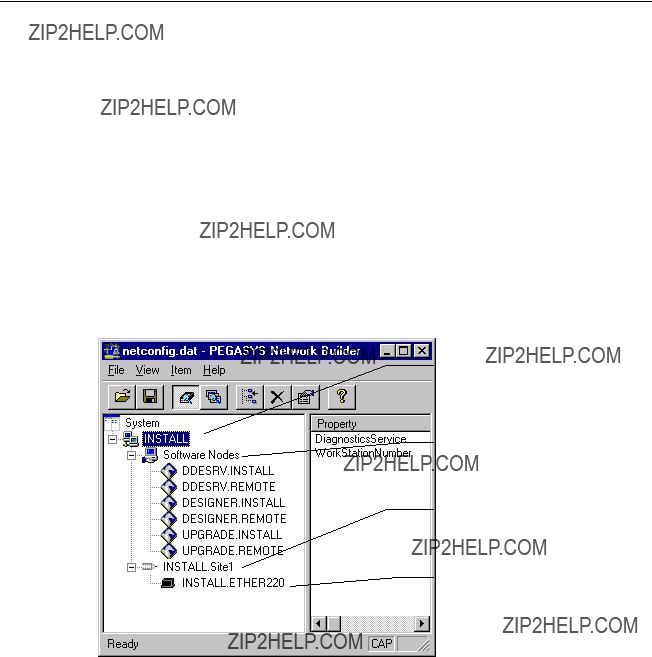
Configuring the EPM Device Network
The PMCS installation routine described earlier in this manual creates initial workstation and software node entries in the EPM 7700 network configuration file. After EPM 7700 software components are installed, the next step is to add Ethernet sites and devices to the PMCS
Running Network Builder
Network Builder software presents your EPM
The first step is to run Network Builder from the Start Menu: (Programs > Power Measurement Ltd > Utilities > Network Builder.)
The following figure shows how Network Builder displays a system comprised of the basic EPM software components, a single EPM 7700 meter, a Primary Node and a Stationless Secondary node (also called a ???view node???).
Workstation: the network name of the
Primary Node computer running the
Communications Server and GE 7700.
Software nodes: Stationless Secondary nodes appear here.
Ethernet Site: Defines the Ethernet connection between the PMCS system and the connected device(s).
Device: Name(s) of attached device(s).

Building the
NetBuilder
When Network Builder is running, you can begin configuring your EPM system by adding a site to the workstation, then adding devices to the site. For larger systems multiple sites are added; one for each network of devices monitored.
NOTE: The PMCS installation wizard creates initial entries for the workstation and software nodes. If you do not need to make changes to the information provided during installation, skip this section and begin with the section title "Adding an Ethernet Site".
Adding a Workstation
When you use the PMCS installation wizard to install a Primary node or Full Station Secondary node, it creates a Workstation in the Network Configuration for you. Stationless Secondary nodes do not appear in the network configuration as workstations, but as software nodes under the Primary workstation. See the section on software nodes for more information.
To add a new workstation, right click ???System??? and choose ???Insert Workstation??? from the

Adding Software Nodes
Software nodes identify the various software components in the network. Stationless Secondary nodes, although they are physically separate computers, do not run a Communications Server and are therefore not considered Workstations by Network Builder. Instead, Stationless Secondary nodes appear in the network diagram as software nodes under the Primary Workstation. Full Station Secondary nodes appear as Workstations because they do run an instance of the Communications Server.
Acknowledging the Add Workstation dialog brings up a message box asking if you want to set up the default software nodes ??? choose Yes to display the software nodes dialog (shown below). Select only ION Designer and Pegasys ION_Link DDE Server as shown, then click OK to proceed. The other options are not supported in PMCS 6.9.

Adding an Ethernet Site
An Ethernet site defines the network connection between the devices and the Workstation(s). You add Ethernet sites to Workstations, then add devices to the sites. To add a new Ethernet site,
An Add Ethernet Site dialog box (shown below) appears.
Set the following communications parameters for the site.
???Enter the Transmit delay setting (in milliseconds). This setting determines the level of traffic on the network. If the PMCS system is the sole user of the network, set this value to 5 (or less) to maximize performance. Increase the transmit delay in situations where the network is shared with other users,
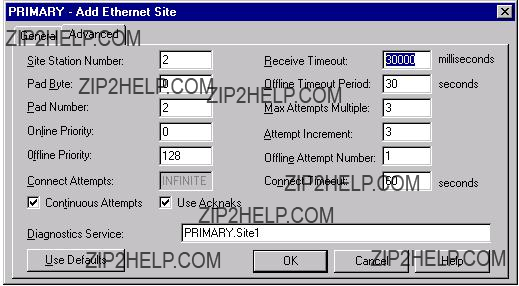
such as on a corporate LAN. Refer to the PMCS Network Architecture Guide for guidelines on setting this parameter for best system performance.
???Change the RX timeout delay from 10000 to 30000 on the Advanced tab. (See the following figure for Advanced tab.)
All other parameters may be left at their default values for most applications. When you click OK in the Add Site dialog box, Network Builder will inform you if there is additional information you must enter.

Adding Devices (Meters)
To add a meter,
Enter the following information:
???Choose the meter type from the Type list (Power Measurement 7700 ION).
???Type a name in the Group box, or choose a Group from the list (by default the Group will be the name of the workstation).
???Enter a name for the meter (or accept the default). The meter name must begin with a letter.
???Enter the IP address for the meter.
???Enter the IP Service Port number (socket) for the meter. For a 7700, 7600 and 7500 ION this number is 7700, for a 3720 ACM, 3721.
Saving and Exiting
Once you have added all of your sites and devices to the network tree, click the Save button (or choose Save from the File menu), and exit Network Builder. You have now configured your EPM 7700, EPM 7600 and EPM 7500 meters to operate with the PMCS, and you should be able to access EPM 7700, EPM 7600 and EPM 7700 metering data from PMCS client applications.
(This page left blank intentionally.)

Using MMS Servers with PMCS
What is an MMS Server?
PMCS is an extremely flexible system which supports generic DDE Servers. One such server is the SISCO
For details on the SISCO
For convenience, installation and setup instructions to prepare an MMS Server for access by PMCS applications are provided here.
System Requirements
The following table shows the minimum recommended PC system configuration for running the MMS Server and software with PMCS Version 6.9. Note that regardless of configuration, the PC system must be Windows
Minimum PC Requirements for using MMS Technology with PMCS
Dual Pentium III processor, 500 MHz or better
Microsoft Windows NT 4.0 Workstation, Service Pack 3 (SP5 recommended),
Windows 2000 Professional, Cimplicity version 4.01 Service Pack 9 or
Cimplicity version 5.0 Service Pack 1
256 megabytes of RAM
512K cache
Super VGA video adapter and monitor

Installation for Windows NT 4.0
The following installation procedures assume that you are familiar with Windows NT 4.0 and your computer.
Carefully read the following notes that pertain to installing your
1.Insert the
2.If the Autorun feature is enabled on your computer, go to Step 3.
Otherwise, click on Start, select Run and enter X:\disk1\setup (where X is the appropriate
3.When the
4.Follow the instructions on the screen to complete the
Note: When the
5.Install the OSI LLC Protocol Driver for Windows NT.
Note: If you are replacing an existing version of the OSI LLC Protocol Driver, you need to remove the current version. Select the Services dialog tab, highlight the OSI LLC Protocol Driver and click the Remove button. Click on OK. Click the Close button and reboot your computer. When the system reboots, set the directory to the Windows System Drivers (System32\Drivers) and delete the file osillc.sys. The installation process will fail to load the correct OSILLC device driver if an older version of the device driver is present in the system directory.
6.Click on Start > Settings > Control Panels. From the Control Panel folder, select the
Network shortcut.
7.Select the Protocols dialog tab and click the Add??? button.
8.From the Select Network Protocol dialog box, click the Have Disk??? button.
9.From the Insert Disk dialog box, type the path {d}:\osillc\winnt, where {d} designates the letter of your
10.From the Select OEM Option dialog box, click on OK, then click the Close button and restart your computer.
11.The following directory structure should now appear on your computer.
Note: If you are installing for both Windows 95 and Windows NT, you should install the product into the same directory. This will allow you to share the same configuration database between both platforms.

Preparing the MMS Server for use with PMCS
The following instructions describe how to set up your MMS Server for DDE access by
PMCS applications such as Event Logger and Waveform Capture. Both MMS Server and
PMCS must be properly installed before following these instructions.
1.Launch the
Choose New to start the wizard for creating a new host. The Host Name Wizard - Host Name dialog box is displayed.

2.Enter a name for the host you are creating, then choose Next to display the Host Name Wizard - Addressing dialog box:
3.Complete the TCP/IP Network question by selecting the Yes checkbox and entering an IP address for the new host, then select Next.

4.From the Host Name Wizard - Finished dialog box, select Add AR Names to display the AR Name Wizard - Host Name dialog box, below.
5.Enter the Host Name of the AR Name being created, then choose Next.
6.You may skip dialog boxes referring to Seletors by using the Next button until the AR Name Wizard - AR Name dialog box appears:

7.Complete the AR Name configuration by entering an AR Name, entering a Comment (optional) and selecting TCP/IP Transport. Choose Next to complete the configuration.
8.When the Finished dialog box appears, select Finished, then Finished again to complete and close the wizard.
(This page left blank intentionally.)
Index
A
alarm, 4
D
DDE Server, 50
E
Ethernet, 4, 9, 16, 17, 45, 47 event, 4
F
Fanuc, 4
First Steps, 8
I
Interface Toolkit, 5, 9, 43, 47
M
minimum system requirements, 3 MMS Server, 59
Modbus Monitor Proxy, 35 Modbus RTU, 4, 9, 45
N
NetBuilder, 48
Network Builder, 48
O
option modules, 4
P
PEGASYS nodes, 49
Performance, 4
S
servers DDE, 50
T
TCP/IP, 4, 9, 10, 16, 47
Technical Support, 3, 8, 11
Terminology, 8
W
waveform capture, 4 Windows NT, 4, 10, 14, 16, 19

GE Industrial Systems
General Electric Company
41 Woodford Ave., Plainville, CT 06062